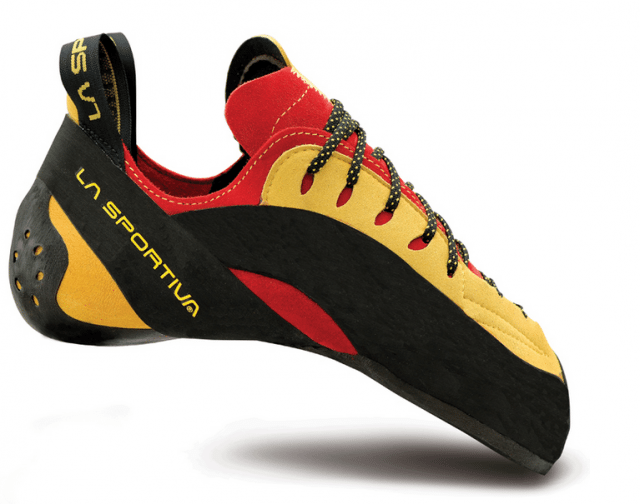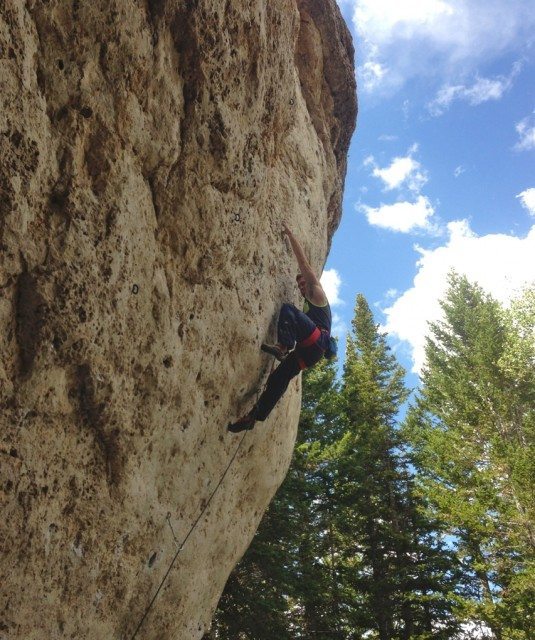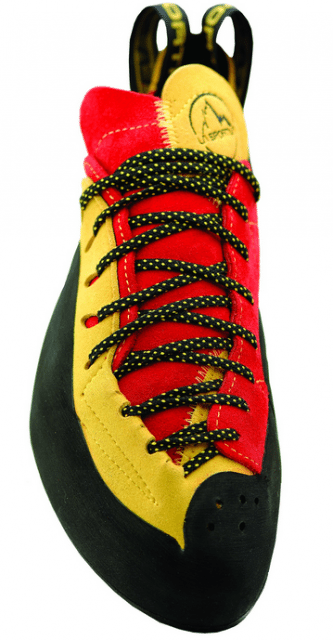
La Sportiva Testarossa
Weight: 7.44 oz / 211 g
Sizes: 33-45 (half sizes)
Size Tested: 39.5
Fit: Performance with high asymmetry
Upper: Leather/ Lorica
Midsole: 3D Hytrel Anatomical insert (under toes) with P3
Sole: 4mm Vibram XS Grip2
Closure: Laces
MSRP: $175
Reviewer’s Foot: Average shape, narrow width, medium arch
Test Locations: Joe’s Valley, UT; Sinks Canyon, Wild Iris, and Wolf Point in Lander, WY; Cueva de la Cabra, Jackson, WY; Teton Canyon, WY; The Fins, ID; Fontainebleau, France; Ticino, Switzerland
Duration of Test: Over a year
[Editor’s Note: We posted our original review of the Testarossa over a year ago. But Matt has continued to climb in the shoe, so we asked him to update his review and tell us how well it was holding up after almost a year and a half of use.]
Nearly a decade old and mostly unchanged, the Testarossa probably doesn’t need much of an introduction. It is a high-level, aggressive, sport-climbing shoe, and the choice of many of La Sportiva’s top athletes—even though it’s often overshadowed by the popular La Sportiva Solution.
I tend to gravitate toward steep, powerful boulder problems and sport climbs, and I typically climb in the Five Ten Dragon—the company’s aggressive lace-up. I’ve always thought that the Dragon provided a great balance between support and sensitivity, and was eager to see how the Testarossa compared.
Toe Box
The Testarossa has an extremely downturned and asymmetrical shape that lets me both pull with my toes and power off even the smallest edges. La Sportiva claims that the aggressively downturned toe box, combined with “a 3D cupped hytrel midsole under the toes,” and a “tension figure-eight rand,” provides a very high level of edging and pulling power.
And I would agree with that claim; when sport climbing, I’ve found that the Testarossa gives me an extremely high level of performance on anything from overhanging limestone to vertical granite.
A couple summers ago in Wyoming, I used the Testarossa on routes such as Cow Reggae 5.13b in Wild Iris, and Super-G 5.13a in Teton Canyon. These routes are very different. Cow Reggae is extremely steep and powerful pocket climbing, while Super-G is technical climbing on dead vertical to slightly overhanging granite. In both situations, the Testarossa let me use my feet with confidence while pulling with my toes on limestone pockets or standing on granite smears.
The Testarossa’s toe box is pretty wide, but the toe is still extremely pointed. I have narrow feet, so this combination was comfortable without sacrificing performance—at least for sport climbing. This is key for a sport climbing shoe: I want performance and precision, but I don’t want to lower off longer pitches in severe pain. Even at the top of long routes like Shaken Not Stirred 5.12a and Martini 5.12a in Idaho, I was able to edge effectively without crippling pain.
All that said, since I do have relatively narrow feet, I found this wide toe box to be a bit of a hinderance when I was bouldering. The slightly narrower toe box of the Dragon feels more precise than the Testarossa, which can feel slightly boxy. For climbers with wide feet, this likely won’t be an issue.

Fit
The Testarossa has an asymmetric, performance fit with a fairly wide toe box and a narrow heel. As I mentioned above, a wider toe box means that climbers— especially those with wider feet—will likely find the Testarossa to perform well without being unbearably uncomfortable.
That’s not to say that these shoes are designed for all-day comfort. They are definitely performance-oriented, and would not be a good choice for a day of multi-pitch climbing.
Personally, I found the Testarossa to be comfortable straight out of the box, despite the fact that I downsized to a USM 7 (39½) from a USM 9½ street shoe. For comparison purposes, I wear the same size in the La Sportiva Solution, and a USM 8½ in the Five Ten Dragon, which is a very aggressive fit. I think the reason the Testarossa is so (relatively) comfortable, despite the drastic downsize, is due to La Sportiva’s bi-lateral stretch technology.
The company uses both leather and Lorica in the Testarossa’s upper. Since leather stretches and Lorica does not, the Testarossa stretches in areas where you want extra space (around the ball and top of the foot), but it doesn’t stretch in areas where you don’t want it to (at the pointed toe). I found that the Testarossa quickly conformed to my foot, but after four of five months of use, they’re still not overly stretched out.
Closure
Since the Testarossa’s lacing system extends all the way down to the toe, I found that when laced down, this shoe feels very snug and secure. The closure also let me cinch the shoe down around the toe box, adjustability that’s very helpful considering my narrow feet.
Granted, taking the Testarossa on and off is more time consuming with the laces than if the shoe was designed as a slipper, or if it had Velcro closures. When I’m climbing outside (either bouldering or sport climbing), this isn’t an issue since I’m primary concerned with performance. But I never use the Testarossa in the gym where I have to constantly remove my shoes—they just take too long to lace up. If you climb primarily indoors, keep this in mind.
One final note regarding the laces. While I often replaced the laces on my Five Ten Dragon, I haven’t yet had to do this with the Testarossa. The laces themselves are run directly through the leather and Lorica of the upper, and after months of use, both the laces and the eyelets show almost no signs of wear.
Heel
Unlike the heel on the La Sportiva Solution, which uses large amounts of padding and rubber, the Testarossa heel is extremely thin and provides a high level of sensitivity. The heel cup is also narrow, and I found it to fit my foot very well.
But while the thin, narrow heel of the Testarossa provides great sensitivity, it also means there’s less rubber coverage. When I’m wearing the Dragon or the Solution, there’s rubber in contact with the rock no matter how I position a heel hook. With the Testarossa, there were times when it was Lorica—not rubber—touching the rock.
While this hasn’t been an issue for me sport climbing (the hooks on most routes tend to be pretty straightforward), I tend to use shoes with more rubber around the heel when I’m bouldering—especially on routes that have crux heel hooks.
NEXT PAGE: Rubber / Durability

